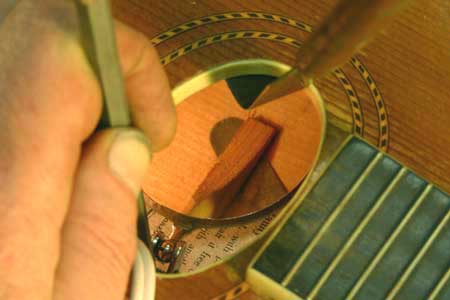Loose Soundhole Brace
© Frank Ford 2003; Photos by FF
I have this little reflex action every time I pick up one of those early Gibson oval hole mandolins:

I reach inside to see if the soundhole brace is loose by squeezing the end of the brace against the top to feel a bit of movement at its end. There's only this one little brace inside the top, and it carries the downward load of string tension past the soundhole, keeping the top from sinking over time. It's such an important structural element, that I'm always on the lookout for any signs of failure. At an average age of more than 80 years, these instruments are prone to joint looseness, and my expectation is that I'll find that brace loose a fair percentage of the time.
Sure enough, you can see how easily I can slip my bent palette knife under the end of the brace:

I'll use this same bent knife to deliver the glue:

While the mandolin was originally made with hide glue, I'll often use aliphatic resin glue for this operation. Hide glue does not work all that well in a joint that's contaminated with a lot of oxidation and dirt, and this brace may have been loose for a couple of generations, so I don't have a lot of confidence about it being very clean in there.
I'll smear some glue on the bottom surface of the knife, leaving the upper surface clean:

Then, as I stick the knife in, I won't rub glue all over the inside of the top until the knife goes under the brace:

I'll try not to pry the entire brace loose in the process, because it would be a lot easier to reglue each end separately than to remove, clean up and replace the brace in exactly the right position.

I give a quick wipe with a damp rag to clean off the excess glue:

And get my little clamp ready. It's a simple C-clamp with a pad on the bottom to distribute pressure on the very tip of the brace:

As long as that feather edge tip of the brace stays glued to the top, the brace will do its job, so I really don't have to clamp the brace anywhere else along its length, unless it had come off completely:

You can't see it in the photo, but I have the top of the mandolin protected with a thin one-inch square leather covered piece of hardwood. I'm using relatively little clamping pressure to avoid crushing that delicate brace.
Back to Index Page